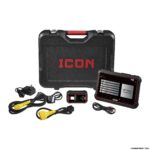Navigating car troubles can be frustrating, especially when a warning light illuminates and you’re far from your trusted mechanic. Many drivers assume that any standard code reader should easily diagnose the issue, thanks to OBD2 standardization. But when faced with a stubborn check engine light on a modern Volvo, like the experience shared about a 2020 XC60, questions arise: Does Volvo Use Obd2, and why might a generic reader fail to connect?
The short answer is yes, Volvo vehicles, including recent models, are equipped with OBD2 ports. OBD2 (On-Board Diagnostics II) is an industry-standard protocol mandated in the USA since 1996 and subsequently adopted in many other countries, including those where Volvo operates. This standardization was primarily driven by emissions regulations, requiring all vehicles to have a system that monitors emissions-related components and allows for external access to this data.
However, the complexity lies in the interpretation and accessibility of the data. While the OBD2 standard ensures a universal port and basic communication protocols for emissions-related codes, it doesn’t mandate access to all vehicle systems or manufacturer-specific diagnostic codes. Think of OBD2 as a common language for basic car health checks, particularly emissions.
The experience described in the original post highlights this nuance perfectly. A 2020 Volvo XC60 triggered a check engine light due to a minor evaporative system issue – a cracked evap line. This is indeed an emissions-related fault. Yet, standard, even “pro” OBD2 readers at various service locations failed to connect or retrieve the code. This isn’t necessarily because Volvo isn’t using OBD2, but more likely due to a few factors:
- CAN Bus Communication: Modern Volvos, like many contemporary vehicles, utilize CAN (Controller Area Network) bus systems for communication between various electronic control units (ECUs). While OBD2 works over CAN, the specific implementation and the reader’s compatibility with Volvo’s CAN protocols can be a factor.
- Manufacturer-Specific Codes: OBD2 standards primarily cover generic powertrain (P-codes) and emissions-related codes. Manufacturers like Volvo often have their own proprietary diagnostic codes (B, C, and U codes) for body, chassis, and network systems that go beyond the basic OBD2 scope. A generic reader might only be designed to read the standardized P-codes.
- Reader Capability: Not all OBD2 readers are created equal. Basic, inexpensive readers are often limited in their capabilities. They might struggle with the communication protocols of sophisticated vehicle systems or lack the software to interpret manufacturer-specific data, even when the car is technically OBD2 compliant for basic functions.
For Volvo owners seeking reliable diagnostic capabilities beyond basic emissions checks, especially for newer models, considering these points is crucial. While a basic OBD2 reader might suffice for some simple issues, a more advanced scan tool is often necessary. These could include:
- Professional-Grade OBD2 Scanners: These offer broader vehicle compatibility, deeper diagnostic capabilities, and often include manufacturer-specific code reading and reset functions.
- Volvo-Specific Diagnostic Tools: These tools, sometimes referred to as “Volvo VIDA” or similar systems, are designed specifically for Volvo vehicles. They provide the most comprehensive diagnostic access, mirroring the tools used by Volvo dealerships.
In conclusion, Volvos are indeed OBD2 compliant. However, the experience of struggling to read codes with generic tools isn’t uncommon and stems from the limitations of basic readers when interacting with advanced vehicle systems and manufacturer-specific diagnostic data. For Volvo owners wanting to be prepared for diagnostic needs, investing in a more capable scan tool, potentially one with enhanced European vehicle compatibility or Volvo-specific features, is a worthwhile consideration. This ensures you’re not left in the dark when that check engine light appears, especially on the open road.
